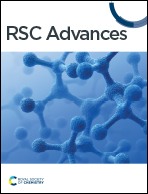Ionic modification of graphene nanosheets to improve anti-corrosive properties of organosilicon composite coatings†
Abstract
Composite coatings with anti-corrosive properties were fabricated using quaternized silicone oil modified graphene oxide and silicone polymer. Quaternized silicone oil was successfully synthesized through copolymerization of octamethyl cyclotetrasiloxane (D4), chloropropylsilane and triethylamine. The quaternized silicone oil modified graphene oxide (M-GO) was characterized by using 1H NMR, FT-IR, Small-angle X-ray scattering (SAXS), Thermogravimetry (TG) and Transmission electron microscopy (TEM). The results showed that the M-GO was formed successfully. The M-GO could be dispersed without aggregation in some organic solvents, and the concentration of M-GO could be up to 3 mg ml−1. The M-GO-reinforced silicone composites exhibited obvious improvements in thermal stability, mechanical properties and especially anticorrosive properties with the highest Ecorr (−121 mV) and the lowest Icorr (6.058 × 10−9 A cm−2), and the protection efficiency of the matrix could reach 99.97%. The anticorrosive mechanism of the fabricated composite coatings was investigated. This work provides a ready strategy for modification of GO and fabrication of high performance graphene-based silicone composite materials.



 Please wait while we load your content...
Please wait while we load your content...